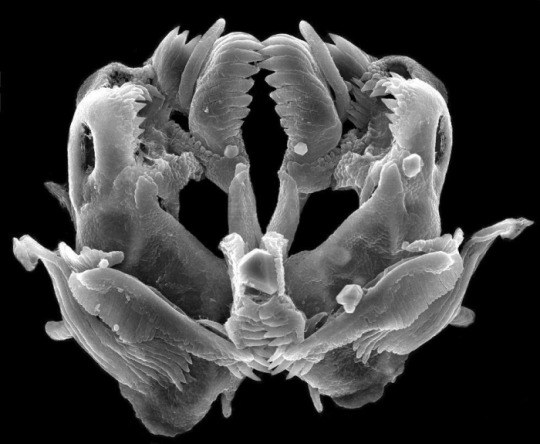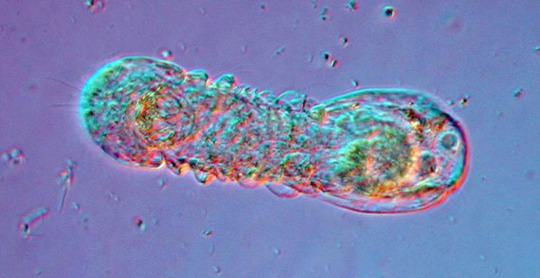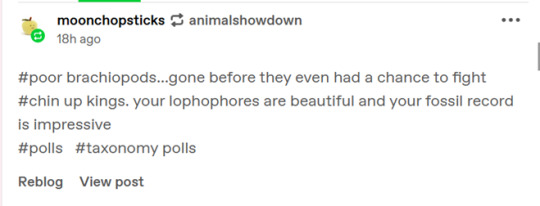#micrognathozoa
Text
Phylum Round 1.5

Xenacoelomorpha: Small, flat, worm-like animals that live in marine and brackish sediments, and sometimes around hydrothermal vents. They can be free-living, symbiotic, or parasitic. A unique feature is that their stomachs lack nerve cells, unlike many other animals. Their evolutionary relationship to the rest of Animalia has been highly debated, and very little is known about their lifestyles.
Micrognathozoa: Presumably the smallest phylum, this group consists of a single species, Limnognathia maerski. In addition to being the smallest phylum, it may also be the smallest animal, with an average length of 100 micrometers. Despite this, it has complex jaws with 15 independently moving parts. Since this phylum has not been well-studied, all individuals that have been collected so far have been female.
#worm on worm violence#cw parasites#xenacoelomorpha#micrognathozoa#micro royale#animal bracket#poll bracket#bracket tournament#tumblr bracket#phylum round 1.5#phylum#phyla will now have a link to their propaganda tag for easy reference of propaganda from past rounds!#sorry this one's posting at a weird time lol I just wanted to take care of round 1.5 as fast as possible
95 notes
·
View notes
Text
Phylum #19: Micrognathozoa!

Why have a pair of jaws when you can have a fifteenuple of them? This microscopic but extremely intricate system of jaws is definitely the star of today's species, Limnognathia maerski. Yes, species. Found in both Greenland and Antarctica, this tiny creature is the only one known in its entire phylum, Micrognathozoa!
Only discovered in the year 2000, the still little-known Limnognathia shows a body plan like no other. On top of the intricate system of jaws - making it likely a gnathiferan, cousin to arrow worms and rotifers -, an accordion-like thorax links its head and abdomen, the latter ending in a transient anus.
Swimming in spirals with the help of ciliated cells and anchoring itself with an adhesive pad, Limnognathia feeds on bacteria, diatoms and other micro-organisms. As the ventral jaws snatch the prey, they are brought to the main jaw system to be chewed and digested.
Limnognathia's life cycle is still poorly known. Only the youngest specimens found displayed male organs, leading researchers to believe them to be sequential hermaphrodites - changing from male to female during their life cycle. The peculiar distribution around both poles, with most specimens recovered from a single cold spring in Greenland, hints at it being a relict from the Cretaceous, when Greenland was still a tropical reef.

#forms and phyla#micrognathozoa#limnognathia#bioblr#hermaphroditism#cretaceous#greenland#kalaallit nunaat#antarctica
36 notes
·
View notes
Text
Currently thinking about how Limnognathia maerski has been found in both Greenland and Antarctica - almost on opposite sides of the Earth (and apparently environmental DNA from it may have been found in the Pyrenees as well, but that data remains unpublished so 🤷🏼).
This means that this tiny organism, this entire phylum, has a potentially worldwide distribution… and we didn’t even discover it until 1994.
There is so much on this planet that we have yet to discover.
1 note
·
View note
Text
WAR AND HATE ON PLANET EARTH
WELCOME TO THE PHYLUM PHIGHT
A BRACKET WHERE THE 37 KNOWN PHYLA OF ANIMALS (extant and otherwise) WILL BATTLE TO THE DEATH. ONLY ONE MAY BE CROWNED CHAMPION-- AND ASCEND TO THE STATUS OF KINGDOM (i have this power)
WHO WILL IT BE? THE CHORDATES, CONTAINING EVERY KNOWN VERTEBRATE INCLUDING YOU AND ME? I FEEL LIKE THAT'S A BIAS. MAYBE THE HUMBLE TARDIGRADES, THE INTERNET'S FAVOURITE EXTREMOPHILES? OR WILL IT BE THE PENIS WORMS? I FEEL LIKE IT'S GONNA BE THE PENIS WORMS.
TOURNAMENT STRUCTURE:

ok ditching allcaps now <3
round 0
preliminary face-off between the odd phellas. lasting one (1) week to give bitches time to mobilise
protoarticulata VS rhombozoa
2. phoronida VS vetulicolia
3. petalonamae VS xenacoelomorpha
4. porifera VS rotifera
5. platyhelminthes VS saccorhytida
round 1
all round 1 poll-batches will last one (1) day because dear god there are so many of them. there will however be a cooldown of like, a couple days or something between batches because i am but one man
batch 1 - BATCH TO THE DEATH
6. priapulida VS winner of 1
7. annelida VS chaetognatha
8. trilobozoa VS micrognathozoa
9. bryozoa VS lorcifera
batch 2 - THE BATCHENING
10. tardigrada VS winner of 2
11. brachiopoda VS gastrotricha
12. mollusca VS winner of 3
13. nematomorpha VS gnathostomulida

batch 3 - BATCHETFIELD HIGH
14. chordata VS winner of 4
15. archaecyatha VS cycliophora
16. nematoda VS nemertea
17. ctenophora VS kinohyncha
batch 4 - I HAVE RUN OUT OF BATCH PUNS
18. arthropoda VS winner of 5
19. agmata VS entoprocta
20. cnidaria VS onychophora
21. echinodermata VS hemichordata
round three wait and see!!!
this bracket doesn't require nominations, as the candidates are already set out all nicey for us by Science. how cool of them. Now we make them beat each other senseless for our sick amusement :)
HOWEVER please send asks, suggest representative species or images to make sure we see them at their best, send propaganda/fun facts youd like the filthy electorate to know before they condemn your fav to the deepest most basal pits of taxonomic superhell. lets all get to know the Beasts together. Before we make them fight to the death.
-mod riz (he/him)

ROUND 0 START: APRIL 10TH
#phylum phight#phylum-phight-tourney#tumblr tournament#taxonomy#tumblr polls#tournament#poll tournament#animal tournament#biology#cnidaria#bryozoa#chordata#arthropod#echinoderm#molluscs
32 notes
·
View notes
Note
Apparently, there is a species of microscopic animal - Limnognathia maerski - that takes the entire phylum (!) for itself only. Imagine yourself in the place of the poor systematican that had to come up with the official names for its genus, family, order... e.t.c.
This guy?

(source)
“Limnognathia maerski is a microscopic freshwater animal, discovered living in warm springs on Disko Island, Greenland, in 1994. Since then, it was also found in Crozet Islands of Antarctica.”
“With an average length of 100 micrometers (μm), it is one of the smallest animals known.”
“It has very complicated jaws, with fifteen separate elements. The parts of the jaw structure are connected by ligaments and muscles. The jaw parts are very small, ranging from 4 μm to 14 μm.”
“All specimens of L. maerski that have been collected have had female organs... The youngest L. maerski specimens collected may also have male organs, and it is now theorized that the animals hatch as males and then become females (sequential hermaphroditism).”
Pretty cool indeed! I like how it's smaller than many single-celled organisms, and has all its body systems stripped to a minimum, and yet it feels the need of jaws with 15 moving parts.
The names of family and order seem to be simply molded on the genus according to usual zoological custom -- Limnognathiidae and Limnognathida. (I think the latter should be "Limnognathiida" but whatev). They seem to have skipped the class altogether, which is pretty understandable, given that here all the ranks between phylum and genus are completely superfluous.
I actually met the guy who described this species once, at a congress. Very friendly and talkative, incredibly thick Danish accent, smell of cigarettes. Besides Limnognathia/Micrognathozoa he also formally described two others phyla of micro-invertebrates -- I think he's the only living scientist who accomplished that.
(always feel free to send me more asks about weird obscure animals, BTW)
EDIT: In fact, if you find this sort of things interesting, I’m working on a series of posts slowly going through all the Tree of Life group by group.
#asks#animals#biology#fucked up#why the hell do ask answers have completely different editing options from regular posts
82 notes
·
View notes
Text
Even more sophonts!

The Extrema with Unlimited Potential, sophont bdelloid rotifers who utilize horizontal gene transfer for both medical and practical purposes, giving them huge adaptability and genetic variation. One individual can have a completely different biological toolset than another due to conscious decisions, on a level far greater than that of human self-improvement. There's a surprisingly even divide between hypercapitalist and communist nations.

The Representative Walks of Life are cow-sized micrognathozoa who encased their brains with complex, chitinous jaws. In technicality, their entire heads are outside of their mouths. They combine chitin with calcium carbonate to have a durable skeleton at large sizes. They have a herd mentality, with most bowing to a matriarch who can often "win" politically just by being large. Coups are arranged via dominance dispute...in terms of debate. Juvenile males are used for most of the labor, and females for intellectual pursuits, seeing as females are generally larger and older than males (being sequential hermaphrodites) and hence less dextrous but with more experience.

The Conquering Forests are entoprocts whose consciousnesses are split between zooids, each with a function that might be regulated to one part of a human's brain. This means that they process and think slower than other sapient, and are thus not very quick to act. Wars are arranged over thousands of years, using weaponry to destroy the memory zooids that provide the context for war. To humans, this would basically be like waging war to "mindwipe" the other side and make them forget why they fought you in the first place. *Continuous* mindwiping with chemical weapons, though, is a war crime.
7 notes
·
View notes
Photo

30-day phyla challenge day 11: micrognathozoa
i should do pride versions of these periodically
i love these cool trans booger worms
#art#my art#artists on tumblr#micrognathozoa#limnognathia#trans#transgender#pride#lgbt#pride month#pride month 2018#30-day phyla challenge#dimetrodone
38 notes
·
View notes
Text








Card descriptions below cut:
Loricifera - The Brush Head card represents smothering. It can be possible to hold on too tightly, squeezing the air and life out of something simply for the sake of holding tight. In a reading this card is a warning – do not allow thoughts, emotions, people, or any other outside source to smother something, to keep it from breathing and allowing it to live. This can include the subject of the reading. This fascinating phylum of animals contains some of the first known multi cellular creatures to survive in completely anaerobic environments. They have specifically evolved to live without an element crucial to nearly all other members of the kingdom – oxygen.
Micrognathozoa – The Limnognathia card represents luck. Sometimes, even when everything is lined up, carefully considered, and greatly planned for, it is all down to luck. At other times, without planning, thought, or meaning, luck brings something along. Luck is an arbitrary turn of fate or sequence of events. Even with all other cards in the reading carefully considered, one must always account for luck, good or bad, in anything that happens. There is always random chance, and in that chance, it may be important to let go of plans and schemes, or to simply understand that there is no greater machination in the world than chance. This phyla, only recently discovered in the 90s, constitutes one species of incredibly tiny multi-cellular animals which are located solely in warm springs in Greenland. Their discovery is a thing of chance, so small and easily missed, and yet discovered to be unique and interesting.
Mollusca – The Octopus card represents intelligence. And just as diverse as this phylum is, intelligence comes in many diverse forms. In a reading, one should consider where one can use ones own kind of intelligence to work through whatever the issue at hand or question before them there may be. Intelligence may not be of a scholastic kind, there are many others that have allowed our species to thrive. And just as we thrive on our own intelligence, the many diverse and branching kinds of intelligence in this phylum are well noted. These are alien intelligence meant to solve specific problems, but the strength and incredible diversity of this phylum points to the strength of varied intelligence.
Nematoda – The Nematode card represents a key. Any lock without a key is a barrier which cannot easily be surpassed. With the right key, however, that which blocks the way can be removed with ease. It may be time to look for the key, rather than beating one's head on the lock. Does the key lie in the other cards in the reading? Or is the key something from the outside needed to contextualize and understand them? That will depend on the subject and surroundings, but regardless, consider where something may be critical to unlocking a stubborn thing. Nematodes are an incredibly vast and bio-diverse phyla, with lifestyles ranging from predator to prey to parasite with every variation in between. Their biomass makes up an incredible volume of life on earth, and they are absolutely critical to many systems, such a soil quality, water quality, aquatic food webs, terrestrial food webs, and others.
Nematomorpha – The Gordian Worm card represents a knot. A knot is a tangle to be undone or something that binds together. In a reading this can represent a mess to be worked through, or a binding not to be undone. Nematomorpha are known to tie themselves in knots, alone or in groups when mating.
Nemertea – The Ribbon Worm card represents fragility. Within a reading one should look to where fragility lies in the subject. Whether it is a physical fragility, a metaphorical one or an emotional or mental one. In finding fragility, it is important to realize its nature, not forcing stress upon something which may be prone to break. A delicate touch is important and good to have, and recognizing where sensitivity and gentleness are needed is important to understand in many situations. This phyla is host to some truly stunning animals, however, many of the marine members of this species are extremely fragile without the electrostatic pressure of water to keep their bodies together, they simply fall apart on land.
Onychophora – The Velvet Worm card represents stickiness in a metaphorical sense. Sticking to something to see it though to its conclusion, or staying with something despite difficulty can be critical qualities to have. At times, staying with something, and sticking to principles and ethos may see through an otherwise difficult decision or time. When in the reading it should be considered where sticking to something may be needed. This phyla, while having many distinct and interesting characteristics, uses a sticky glue-like slime to catch prey, and demonstrates incredible effectiveness with as much.
Orthonectida – The Orthonectida card represents the parallel. Parallel lines travel along the same path, yet never meet. This is neither positive nor negative this is mathematical. One should consider then, where parallels lie between their lives and others, and whether they dwell on these or accept them as simply things that are. In relation to other cards in the reading, consider where their reading may interact with parallels, how they may reinforce following the same or breaking away from them. This small and poorly known phylum is defined by it's extremely simple body plan, consisting of two concentric layers of cells which surround little more than sex cells and possibly pigments. They are known only as parasites of various marine invertabrates.
14 notes
·
View notes
Text
New Post has been published on Reeko's Mad Scientist Lab
New Post has been published on http://reekoscience.com/science-resources/reekos-list-of-animal-classes-for-each-phylum-of-the-animal-kingdom
Reeko's list of animal classes for each phylum of the animal kingdom
Unknown phylum Micrognathozoa Acanthocephala (thorny-headed worms) Archiacanthocephala Eoacanthocephala Palaeacanthocephala (ancient thornheads) Acoelomorpha (simple soft-bodied flatworms) Acoela Nemertodermatida Annelida (segmented worms) Aelosomata Clitellata (earthworms) Myzostomida Polychaeta (bristle worms) Echiura (spoon worms) Sipuncula (peanut worms) Arthropoda (arthropods: insects, crustaceans, arachnids, centipedes, and millipedes) Chelicerata Arachnida (spiders, scorpions, and kin) Xiphosura (horseshoe crabs; only 4 extant species) Pycnogonida (sea spiders) Crustacea Branchiopoda (fairy shrimp, tadpole shrimp, water fleas, and clam shrimp) Cephalocarida (horseshoe shrimp; only 12 described species) Malacostraca (crabs, lobsters, crayfish, krill, various shrimp, woodlice, and kin) Maxillopoda (barnacles, copepods, fish lice, and other groups) Ostracoda (seed shrimp) Remipedia Hexapoda Entognatha (coneheads, two-pronged bristletails and springtails) Insecta (insects) Myriapoda Chilopoda (centipedes) Diplopoda (millipedes) Pauropoda Symphyla (pseudocentipedes) Brachiopoda (“lamp shells”) Craniforma Rhynchonellata Bryozoa (moss animals) Gymnolaemata Phylactolaemata Stenolaemata Chaetognatha (arrow worms) Archisagittoidea Sagittoidea Chordata (vertebrates, tunicates, and lancelets) Cephalochordata Leptocardii (lancelet) Tunicata Appendicularia (larvaceans) Ascidiacea (sea squirts) Sorberacea Thaliacea (salps, pyrosomes, and doliolids) Vertebrata Agnatha Cyclostomata Myxini (hagfish) Petromyzontida (lamprey) Gnathostomata […]
0 notes
Text
Phylum Round 2

Chordata: All animals with a backbone (Vertebrata), but also some invertebrates. Chordata includes fish, birds, mammals, reptiles, and amphibians, but also sea squirts and lancelets. All Chordates have a notochord (supportive rod-like structure), a hollow dorsal nerve cord, pharyngeal slits (for filter feeding/breathing), a post-anal tail, and an endostyle (feeding organ) or thyroid (hormonal gland). Interestingly, many Chordates have overcome the need to raise their young in water by laying shelled eggs or carrying young within the womb. Fur, feathers, and scales are all unique adaptations found within Chordata. This phylum exhibits remarkable diversity overall.
Micrognathozoa: Presumably the smallest phylum, this group consists of a single species, Limnognathia maerski. In addition to being the smallest phylum, it may also be the smallest animal, with an average length of 100 micrometers. Despite this, it has complex jaws with 15 independently moving parts. Since this phylum has not been well-studied, all individuals that have been collected so far have been female.
#chordata#micrognathozoa#animal bracket#tumblr bracket#bracket tournament#poll bracket#phylum round 2#phylum
60 notes
·
View notes
Text

28 notes
·
View notes
Text
Okay, have some fun facts about all of the small (under 1,000 known species) animal phyla that I found diving through Wikipedia.
Brachiopoda: Used to fill the position that bivalves fill now, which technically makes bivalves Brachiopoda 2.0.
Chaetognatha: Some species have an “oil vacuole” organ that might help them maintain buoyancy (basically a swim bladder). Also, some of them produce tetrodotoxin. Also also, some of them are bioluminescent.
Ctenophora: Double anuses (only recently discovered). Also, they used to have skeletons.
Cycliophora: Weirdly complex reproductive cycle involving two modes and three sexes (female / male / sexless). Would make an interesting basis for a fictional species… if you can even understand what’s going on.
Dicyemida: Alternation of generations, apparently.
Entoprocta: Organs can do a complete 180° flip in position during metamorphosis.
Gastrotricha: Live for only a few days, and their bodies are “filled with poorly differentiated connective tissue”.
Gnathostomulida: Instead of laying eggs like reasonable animals, they have their eggs straight-up BURST OUT OF THE PARENT’S BODY. (They’re fine, though.) Also, they have no (permanent?) anus.
Hemichordata: Can have a hundred pairs of gill slits.
Kinorhyncha: Retractable head.
Loricifera: Some species can survive without oxygen. Whether or not they even have mitochondria is up for debate.
Micrognathozoa: Fifteen-part jaws… on an animal that’s only 100 micrometers long. They certainly live up to their name.
Nematomorpha: Because they can influence their hosts to enter water, they help feed certain types of fish.
Onychophora: Unexpectedly complex social structure. Also, they are matriarchal (girlboss).
Phoronida: “The blood of Phoronis architecta carries as much oxygen per cm3 as that of most vertebrates; the blood’s volume in cm3 per gm of body weight is twice that of a human.”
Placozoa: Have several different types of sodium channels for some reason.
Priapulida: Very dense populations despite the small number of species.
Xenacoelomorpha: One species is photosynthetic because of symbiotic algae (also, two of the common names for that species are “mint-sauce worm” and “shilly-shally worm”).
10 notes
·
View notes
Text
Further thoughts on phylum fighting game:
-micrognathozoa boss
That is all
#ideas#micrognathozoa#apparently that phylum is mentioned so infrequently spellcheck doesn't know what it is
0 notes
Text
Official Phylum Bracket!
Below is the official matchup list for the Phylum rounds!
There are 33 phyla in the Showdown lineup, so after the polls close on Round 1, the winner of Xenacoelomorpha vs. Hemichordata will go up against Micrognathozoa in Round 1.5 before we move on.

How this bracket was created:
After assembling the list of phyla, I ranked them based on my best guess of how they would perform in the polls. I then split the list into the Top 16 and the Bottom 16 (minus Micrognathozoa), and created a bracket for each half using this site. I split up the list because it felt unfair not to give the less charismatic phyla at least a chance to compete! I've been affectionately calling the Bottom 16 matchups the "Micro-Royale" :) From there, I created a new bracket, alternating matchups between the Top 16 and Bottom 16.
Since Tumblr is probably going to crunch the image quality, the bracket matchups are listed in text format below the Keep Reading.
Round 1:
Round 2:
Arthropoda vs. Brachiopoda
Priapulida vs. Placozoa
Platyhelminthes vs. Onychophora
Loricifera vs. Gastrotricha
Annelida vs. Nematoda
Cycliophora vs. Gnathostomulida
Phoronida vs. Cnidaria
Dicyemida vs. Chaetognatha
Mollusca vs. Bryozoa
Nematomorpha vs. Orthonectida
Nemertea vs. Ctenophora
Acanthocephala vs. Tardigrada
Echinodermata vs. Porifera
Rotifera vs. Kinorhyncha
Entoprocta vs. Chordata
Xenacoelomorpha vs. Hemichordata
>> (Micrognathozoa will challenge the winner of this matchup)
Arthropoda vs. Placozoa
Onychophora vs. Loricifera
Annelida vs. Cycliophora
Cnidaria vs. Chaetognatha
Mollusca vs. Nematomorpha
Ctenophora vs. Tardigrada
Echinodermata vs. Rotifera
Chordata vs. Micrognathozoa
Round 3:
Arthropoda vs. Onychophora
Annelida vs. Cnidaria
Mollusca vs. Ctenophora
Echinodermata vs. Chordata
98 notes
·
View notes
Text
Congratulations to the Phylum Round 1 winners!
The lucky phyla that will be moving on to the next round will be: Arthropoda, Placozoa, Onychophora, Loricifera, Annelida, Cycliophora, Cnidaria, Chaetognatha, Mollusca, Nematomorpha, Ctenophora, Tardigrada, Echinodermata, Rotifera, Chordata, and Xenacoelomorpha.
*** As a reminder, before Round 2 begins, Xenacoelomorpha will be going up against Micrognathozoa first. ***
Here are some fun facts about Round 1!
The top 3 closest matches were Xenacoelomorpha vs. Hemichordata (1%), Nematomorpha vs. Orthonectida (5.2%), and Onychophora vs. Platyhelminthes (14%).
The top 3 matches with the widest margin were Dicyemida vs. Chaetognatha (80.8%), Acanthocephala vs. Tardigrada (76.8%), and Cnidaria vs. Phoronida (74.4%).
The most-cheered-for phylum was Platyhelminthes, with roughly 46 positive comments. This is followed by Mollusca with ~30 positive comments.
The least-cheered-for phyla were Kinorhyncha, Acanthocephala, and Loricifera, with roughly 1 positive comment each. (Note that I may have misunderstood some people's responses, and I didn't count responses that were not actively positive. My count is subjective!) Don't worry, they'll be okay! In my scientific opinion, these little guys know they are very loved. <3
Highlight reel and summary of Round 1 below the Keep Reading!
This bracket includes a lot of phyla that many people were not aware of beforehand! There was a lot of marveling over these unfamiliar animals, summed up very well by @transcyberism and @space-candy:


Arthropoda was, predictably, a pretty popular phylum, so folks (@moonchopsticks, @rotationalsymmetry) had some sympathy for its opponent, Brachiopoda:


There was quite the outcry when folks realized that Echinodermata and Porifera had been pitted against one another! Much ruckus was raised over unintentionally pitting two bad bitches against each other. The scandal can be summed up neatly by @dumbratinjade, @ploridafanthers, and @capripian:

As Chordata surged forward in the polls, many folks (@luncheon-aspic) had suspicions about the reason behind its success:

Some of the more niche phyla got some love! A small selection...
Proof of the absurdity of the animal kingdom (@qsatisfaction):

Our ace champions (@oracle-moment):

Star Wars ass creatures (@jupesontherun):

The most relatable sentence to me, rosybetta, known intertidal mud flat enjoyer (@ploridafanthers):

Overall this round was a huge success! To everyone who sent in propaganda, thank you! All of us learned so much!
60 notes
·
View notes
Text
Introducing Life, One Phylum at a Time
Welcome to Forms and Phyla! Each day, a short presentation of one of the animal kingdom's 32 described phyla, highlighting its diversity and uniqueness!
Watch the tree of life - and the blog's profile picture - light up before your eyes, as a new facet of animal diversity is revealed each time!
Click here for the latest post (Gastrotricha, the hairybellies), or see below for the list of posts!
Ctenophora
Porifera
Placozoa
Cnidaria
Xenacoelomorpha
Echinodermata
Hemichordata
Chordata
Loricifera
Kinorhyncha
Priapulida
Nematoda
Nematomorpha
Tardigrada
Arthropoda
Onychophora
Chaetognatha
Rotifera
Micrognathozoa
Gnathostomulida
Mollusca
Entoprocta
Gastrotricha
104 notes
·
View notes